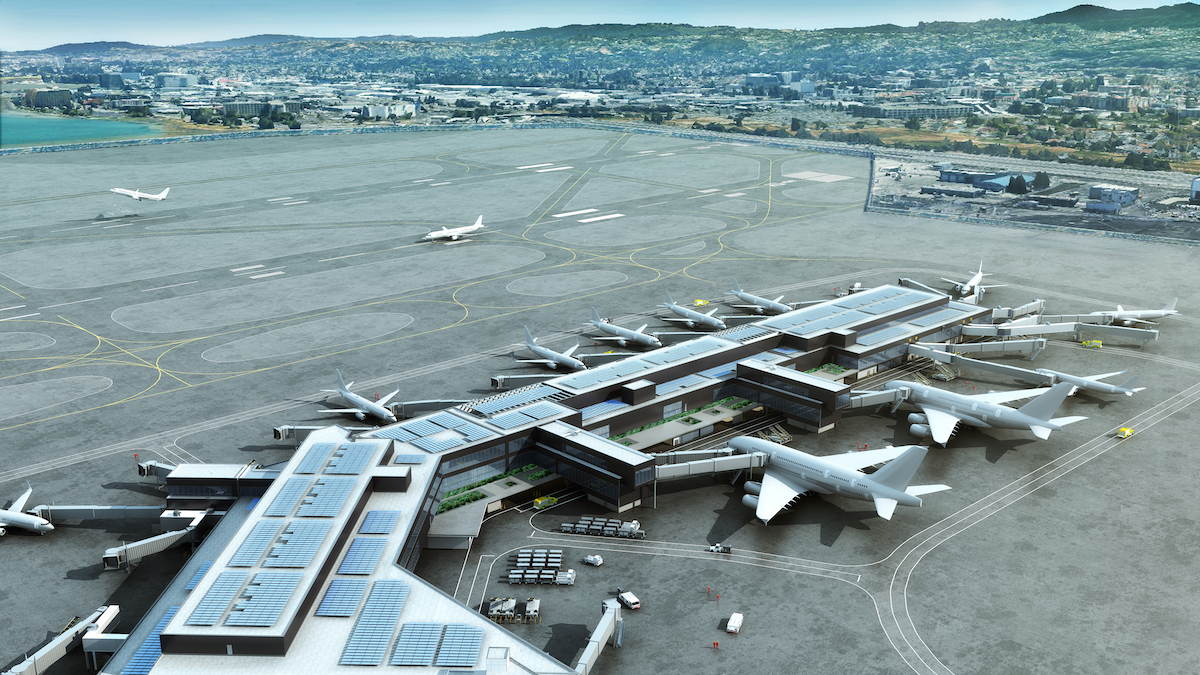Aging facilities, rising passenger and cargo volume, and surging technology requirements are fueling a period of unprecedented redevelopment at airports across North America.
“The aviation market is busier than I’ve seen it in my 25 years in the industry,” says Dwight Pullen, Senior Vice President and National Director of Skanska’s Aviation Center of Excellence. “The U.S. is one of the most mature aviation markets in the world. The average age of major hub airport terminals is 40 to 45 years old.”
What’s most striking about the current wave of aviation work isn’t necessarily the raw number of projects, but the sheer scale of them. Numerous U.S. airports are undergoing modernization programs with construction values exceeding $1 billion.
“We used to see these mega jobs every three to five years, but now we’re seeing several come out each year, at airports of all sizes,” says Pullen.
Related content: Top 50 Airport Architecture Firms
Related content: Top 60 Airport Engineering Firms
Related content: Top 55 Airport Construction Firms
The new Eastern Concourse that opened at New York’s LaGuardia Airport in late 2018 was the first component of a $4 billion phased redevelopment of Terminal B. The improvements are part of a broader $8 billion blueprint to redevelop the entire airport, unifying all terminals under one roof and replacing aging, inefficient infrastructure.
Other multibillion-dollar terminal redevelopment projects currently under construction include a new terminal complex and infrastructure at Salt Lake City International Airport; an expansion of Terminal 1 at San Diego International Airport; redevelopment of Terminal 1 at San Francisco International Airport; a new Central Passenger Terminal Complex at Atlanta’s Hartsfield-Jackson International Airport; a new South Terminal Complex at Orlando International Airport; and a new Midfield Satellite Concourse at Los Angeles International Airport.
Despite record passenger volume and the disruption of major construction projects, North America airports achieved a record high passenger satisfaction scores in the J.D. Power 2018 North America Airport Satisfaction Study.
A planned expansion of Chicago’s O’Hare Airport attracted a who’s-who of architects eager to design the new 2.25-million-sf global terminal, a signature element of the airport’s broader $8.5 billion expansion. Chicago-based Studio Gang earned the assignment, together with design collaborators STL Architects, Solomon Cordwell Buenz, Corgan, and Milhouse Engineering & Construction.
To fund and streamline the construction of projects, airports are increasingly embracing alternative procurement and delivery methods such as public-private partnerships (P3) and design-build. The airlines themselves, many of which are experiencing strong financial performance, are often investment partners in these capital projects.
At Seattle-Tacoma International Airport, the new 32,400-sf Concourse D Annex opened less than 12 months after ground was broken. The project’s integrated design-build team included The Walsh Group and HOK, working with the Port of Seattle. “Given the strong demand for additional terminal capacity, and speed-to-market considerations for airlines looking to add or increase service, our clients have been very interested in evaluating accelerated delivery options,” says Thomas Haag, Vice President and National Director of Aviation at The Walsh Group.
Airport expansions provide key opportunities for boosting non-aeronautical revenue through expanded retail and food-and-beverage concessions, as well as new technology experiences made available to passengers.
“Everyone is focused on enhancing the passenger experience to provide reasons for someone to get to the airport early and spend more time—and money—while they’re waiting for a flight,” says Skanska’s Pullen. “And parking is also a top revenue driver. With Uber and Lyft, you’d think it would be declining, but we’re still seeing airports building new parking structures to extend their parking revenue.”
For airport owners, operators, and partners, terminal redevelopment projects also represent a high-stakes opportunity to boost economic development and tourism activity while contributing to a favorable first impression of a city.
“Cities and regions continue to emphasize their airport terminals as civic symbols and economic engines,” says Pat Askew AIA, LEED AP, Principal and Director of Aviation at HKS in Chicago. “The recent efforts by cities to land major business headquarters like Amazon HQ2 prove how critical airports are to a city’s economic health, quality of life, and ability to compete with other cities and regions.”
Beyond facilitating air travel, airports are also serving as a home base for broader redevelopment initiatives.
The former headquarters of Braniff International Airways, a landmark building that has been vacant for more than a decade, is getting new life as an aviation hub that anchors a mixed-use development along the east side of Dallas Love Field. Scheduled to open this summer, the 26-acre Braniff Centre redevelopment project includes more than 180,000-sf of hangar space, aviation support facilities, and retail and entertainment components. Burns & McDonnell and The Gravity Company collaborated on the design.
Biometrics IMPROVE AIRPORT SECURITY AND EFFICIENCY
As global passenger volume continues to grow, advanced technology is increasingly valuable for improving efficiency, security, and passenger satisfaction
Facial recognition technology and other types of AI-derived biometrics are already in place at many airports, primarily to enhance security for passengers leaving U.S. terminals on international flights. “It’s both a security enhancement and a means of enhancing self-service and facility throughput, which is a benefit for travelers,” says David Yeamans, President of the Aviation and Federal Group at Burns & McDonnell in Kansas City.
U.S. Customs and Border Protection is working toward implementing biometric exit technology to cover more than 97 percent of departing commercial air travelers within the next four years.
In late 2018, Atlanta's Hartsfield Jackson International Airport and Delta Air Lines opened the nation's first curb-to-gate biometric terminal. Facial recognition technology saves an average of two seconds for each customer at boarding, or nine minutes when boarding a wide body aircraft, based on initial data.
And AI opens up far more opportunities than just streamlining the boarding process. “The design and construction industry may see all-new processes, including innovative wearables that can integrate construction with models in real-time, so crafts or trades know exactly when they are installing something correctly,” says Yeamans. “The opportunities for enhanced safety and health practices also are enormous.”
MORE FROM BD+C'S 2019 GIANTS 300 REPORT
Related Stories
AEC Tech | Feb 13, 2020
Exclusive research: Download the final report for BD+C's Giants 300 Technology and Innovation Study
This survey of 130 of the nation's largest architecture, engineering, and construction firms tracks the state of AEC technology adoption and innovation initiatives at the AEC Giants.
Giants 400 | Jan 26, 2020
2020 call for entries: BD+C awards programs DEADLINES EXTENDED!
NOTE: Due to the delays related to COVID-19, we have extended the submission deadlines for Giants 300 surveys, Building Team Awards, and 40 Under 40. Please email David Barista at dbarista@sgcmail.com with any questions or concerns. Thanks!
Giants 400 | Jan 23, 2020
Government Buildings Sector Giants Report for 2019 [Updated]
AECOM, HOK, Jacobs, and Turner Construction top the rankings of the nation's largest government buildings sector architecture, engineering, and construction firms, as reported in Building Design+Construction's 2019 Giants 300 Report.
Esports Arenas | Dec 23, 2019
2019 Sports Facilities Sector Giants Report: These ain’t your grandpa’s sports stadiums
eSports stadiums may only house a fraction of the fans compared to traditional stadiums, but when it comes to fan-centric technology they are second to none.
Reconstruction & Renovation | Nov 6, 2019
The silent giant: Reconstruction sector makes big impact on firms
More than a quarter of AEC firms that participated in the 2019 Giants 300 survey earned at least half of their total 2018 revenue from the reconstruction sector.
Giants 400 | Oct 25, 2019
Top 55 Airport Sector Construction Firms for 2019
Hensel Phelps, AECOM, Turner, Skanska, and PCL top the rankings of the nation's largest airport terminal sector contractors and construction management firms, as reported in Building Design+Construction's 2019 Giants 300 Report.
Giants 400 | Oct 25, 2019
Top 60 Airport Sector Engineering Firms for 2019
Jacobs, Arup, Burns & McDonnell, Ghafari Associates, and Kimley-Horn head the rankings of the nation's largest airport terminal sector engineering and engineering architecture (EA) firms, as reported in Building Design+Construction's 2019 Giants 300 Report.
Giants 400 | Oct 25, 2019
Top 50 Airport Sector Architecture Firms for 2019
AECOM, Gensler, HNTB, Corgan, and HOK top the rankings of the nation's largest airport terminal sector architecture and architecture engineering (AE) firms, as reported in Building Design+Construction's 2019 Giants 300 Report.
Giants 400 | Oct 24, 2019
Top 80 Retail Construction Firms for 2019
PCL, VCC, Whiting-Turner, Shawmut, and W.E. O'Neil top the rankings of the nation's largest retail sector contractors and construction management firms, as reported in Building Design+Construction's 2019 Giants 300 Report.
Giants 400 | Oct 24, 2019
Top 70 Retail Engineering Firms for 2019
Jacobs, Kimley-Horn, Henderson Engineers, and Core States Group head the rankings of the nation's largest retail sector engineering and engineering architecture (EA) firms, as reported in Building Design+Construction's 2019 Giants 300 Report.

















